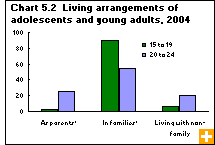Common menu bar links
Children and youth
Archived Content
Information identified as archived is provided for reference, research or recordkeeping purposes. It is not subject to the Government of Canada Web Standards and has not been altered or updated since it was archived. Please contact us to request a format other than those available.
Canadian children are much healthier than earlier generations and most are reaching their teens in good or excellent health. Moreover, fewer infants are dying from illnesses, fewer children are growing up in low-income families, and more teens are finishing high school and pursuing postsecondary education. After graduation, job prospects are good.
In 2006, there were 10 million children, adolescents and young adults under age 25. Of those, 6 million were under 15 years of age, 2 million were aged 15 to 19 and 2 million were aged 20 to 24. The share of the population under 25 has fallen over the last three decades, from 48% in 1971 to 31% in 2006.
In older age groups, women outnumber men; however, there are slightly more young males than young females. In 2006, 51% of Canadians under the age of 25 were male, and 49% were female.
Living arrangements
In 2004, 6 million people 19 and younger, or 75% of this age group, were living in a two-parent family, and 1.8 million children and adolescents, or 23%, were living with one parent, compared with 21% in 2000.
While it is not common, some children live with grandparents. According to the 2001 Census, 190,810 children under 15, or 3.3%, lived in the same household as one or more of their grandparents. Of these, 25,245 children, about 0.4%, lived in the same household as their grandparents and without their parents.
Few young people are parents themselves. In 2004, just 3% of young people aged 15 to 19 had children and were living as a couple or as a single parent. Another 7% in this age group lived alone or with non-relatives.
Young adults aged 20 to 24 live in a wider range of family types than those 19 and under. In 2004, 20% were living on their own or with non-relatives, and 25% were parents themselves. However, the majority, 55%, were living in a two-parent or a lone-parent family.
Health status
The health status of children and adolescents has improved in recent decades: infant mortality rates have decreased and several infectious diseases, such as diphtheria, acute poliomyelitis and scarlet fever, which used to kill many children, have been nearly eradicated. The majority of newborns have a healthy birth weight, above 2,500 grams.
Despite medical progress, 2,515 children aged 14 and younger died in Canada in 2004. More than 70% of these children died before age 1, primarily because of a condition or disease that occurred before or during birth. Injuries and accidents remain the leading cause of death among children aged 1 to 14. Despite its rare incidence, cancer is the most common potentially fatal illness and the second leading cause of death in this age group.
A growing number of children and young people are overweight. In 2004, 26% of children and adolescents aged 2 to 17 were overweight or obese according to their body mass index, compared with 15% in 1979, a 73% increase. Data from 2004 show that 59% of children and adolescents ate fewer than five servings of fruits and vegetables per day, the recommended minimum number of servings according to the 2004 Canada’s Food Guide. These young people were more likely to be overweight or obese than those who ate fruits and vegetables more often.
Fewer adolescents are smoking today. In 2001, 14% of young people aged 12 to 17 smoked cigarettes every day or occasionally—in 2005, that was down to 8%. By contrast, 40% in that age group were exposed to second-hand smoke, compared with 23% for the Canadian population.
Among teenagers who drank alcohol regularly, 31% of drinkers aged 15 to 19 drank heavily—that is, consumed five or more glasses of alcohol on a single occasion at least 12 times a year in 2005. A higher proportion of boys than girls drank heavily: 38% of boys and 25% of girls.
Work and play
Just over half of preschool children attend some type of child care service. By age 4 or 5, most are enrolled in school, where they remain until at least age 16 or 17.
The number of young people pursuing postsecondary education has climbed, particularly university enrolment among those aged 18 to 24. From 1995/1996 to 2003/2004, the university student population in this age group grew 27%, reaching 990,400 students.
Even though the proportion of students who work while attending school has fallen since 1989/1990, 31% of high school students aged 15 to 17 were employed during the 2004/2005 school year. The percentage of students aged 18 to 24 who held a job during the school year was higher at 46%. Thanks to a vigorous economy, job creation for young people aged 15 to 24 grew 21% from 1997 to 2004—the equivalent of 428,000 new jobs.
Many young people spend part of their free time watching television, playing video games and using computers. In 2004, young people aged 12 to 17 spent an average of 10 hours each week watching television. If the time spent on a computer or playing video games is added, young people spend an average of 20 hours each week in front of a screen.





